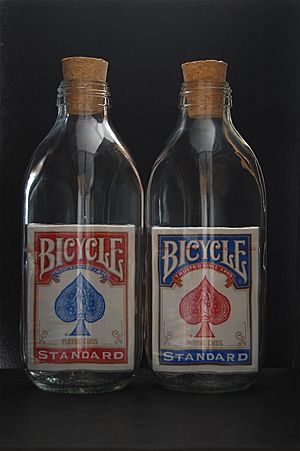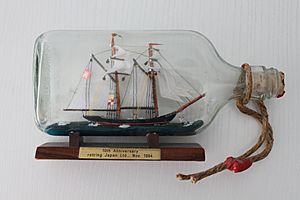Impossible bottle facts for kids

An impossible bottle is a special kind of bottle. It holds an object that looks too big to fit through the bottle's opening. It's like a magic trick, but it's all about clever building!
The most famous impossible bottle is probably the ship in a bottle. But people also put other things inside, like fruits, matchboxes, decks of cards, tennis balls, racketballs, Rubik's Cubes, padlocks, knots, and scissors. There are different ways to get these objects inside. You might build them from smaller parts, use something small that grows, or even shape the glass around the object.
Contents
Building a Ship in a Bottle
There are two main ways to put a model ship inside a bottle. The simpler method involves building the ship so its tall parts, like the masts, can fold down.
How Ships Are Built Inside
First, the masts, spars (poles), and sails are made separately. They are then attached to the ship's hull (the main body) with small hinges and strings. This lets the masts lie flat against the ship's deck.
Next, the folded ship is carefully pushed into the bottle. Once inside, the builder pulls the strings. This makes the masts stand up straight. The ship's hull must still be small enough to fit through the bottle's opening. Sometimes, bottles with slight bumps or colored glass are chosen. These small flaws can help hide the tiny hinges on the masts.
Another way is to build the whole ship piece by piece inside the bottle. This needs special long tools. It takes a lot of patience and skill!
History of Ship Bottles
The oldest known ships in bottles were made by Giovanni Biondo. He created them in the late 1700s. Two of his models look like large Venetian warships. These models were quite big and expensive. The bottles were about 45 cm (18 inches) tall. They were meant to be displayed upside down.
One of Biondo's oldest ships (from 1784) is in a museum in Lübeck, Germany. Another (from 1786) is owned by a private collector. A third (from 1792) is in the Navy Museum in Lisbon, Portugal. It seems to be a model of a large warship called the PN Fama. Another old model from 1795, made by someone unknown, is in a museum in Rotterdam.
Ships in bottles became more popular later on. This happened in the second half of the 1800s. By then, clear glass bottles were made cheaply in factories. This made it easier for many people to create these cool art pieces.
A large collection of ships in bottles is the Dashwood-Howard collection. You can see it at the Merseyside Maritime Museum in England.
Objects That Grow Inside Bottles
Some impossible bottles use objects that expand or grow naturally.
Pine Cones in Bottles
One cool trick uses pine cones. Pine cones open up as they dry out. To make this display, a closed, damp pine cone is put into a bottle with a narrow opening. Then, the cone is allowed to dry inside the bottle. As it dries, it opens up and becomes too big to come out!
Fruits and Vegetables in Bottles
You might have seen bottles with fruit inside, like pears. This is done by placing a bottle around a young fruit or flower while it's still on the plant. The bottle is then tied securely to the plant. The fruit then grows to its full size inside the bottle. This method is often used to put pears into bottles of pear brandy.
Penny in a Bottle
A US one-cent coin sealed inside a small bottle is a common souvenir. These are made in large numbers using a process called glassblowing.
How Penny Bottles Are Made
First, a coin is placed inside a glass cup that is partly melted and very hot. Then, the open end of the glass cup is reshaped. It is pulled and squeezed to form a narrow neck and mouth. This finishes the bottle with the penny trapped inside. If the object isn't metal, like a piece of paper, it needs protection from the hot glass. Sometimes, a fireproof cloth is used to keep it safe from burning.
See also
 In Spanish: Botella imposible para niños
In Spanish: Botella imposible para niños


